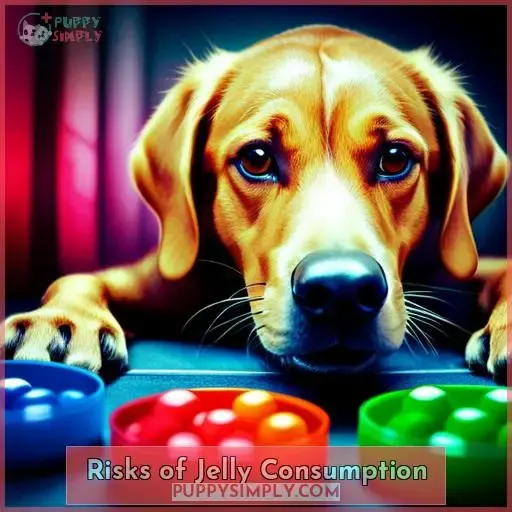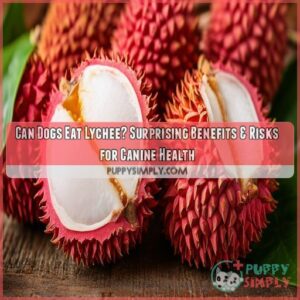This site is supported by our readers. We may earn a commission, at no cost to you, if you purchase through links.
 Craving a sweet treat and wondering if you can share some jelly with your furry friend? Find out now – can dogs eat jelly?
Craving a sweet treat and wondering if you can share some jelly with your furry friend? Find out now – can dogs eat jelly?
While it may be tempting to give them a taste, it’s important to know that jelly isn’t suitable for dogs. Packed with sugar and potential toxic ingredients, regular consumption of jelly could harm your dog’s health.
Stick to safe homemade options or consult your veterinarian for guidance on what treats are best for your canine companion.
Table Of Contents
- Key Takeaways
- Why is Jelly Bad for Dogs?
- Risks of Jelly Consumption
- Can Dogs Eat Homemade Jelly?
- What to Do if Your Dog Eats Jelly
- Can Dogs Have Grape Jelly?
- Can Dogs Eat Different Types of Jelly?
- Can Dogs Eat Sugar-Free Jelly?
- Can Dogs Eat Peanut Butter and Jelly?
- Can Dogs Eat Petroleum Jelly?
- Can Dogs Eat Jam?
- Frequently Asked Questions (FAQs)
- Conclusion
Key Takeaways
- Jelly can be harmful to dogs due to its high sugar content, which can lead to obesity, diabetes, and weight management problems.
- Some jellies may contain toxic artificial sweeteners like xylitol, while others may contain toxic fruits like grapes and raisins, which can be highly dangerous for dogs.
- Homemade jelly often contains high levels of sugar and may include toxic fruits, so it is best to avoid giving dogs any type of jelly and prioritize their overall well-being.
- If a dog accidentally consumes jelly, it is important to seek immediate veterinary advice and monitor for symptoms such as vomiting, diarrhea, excessive thirst, and abdominal pain.
Why is Jelly Bad for Dogs?
Jelly is bad for dogs due to its high sugar content and potential toxic ingredients.
The main danger of jelly lies in its high sugar levels, which can lead to various health issues in dogs.
Regular consumption of jelly can contribute to obesity and diabetes in dogs, as well as dental problems caused by the excessive sugar intake.
Additionally, some types of jelly may contain grapes or raisins, both of which are highly toxic fruits for dogs. These fruits can cause kidney failure and other serious complications if ingested by a dog.
To ensure your dog’s safety, it’s best to avoid feeding them any type of jelly altogether and instead opt for homemade alternatives that are specifically made with safe ingredients suitable for pets’ consumption.
Risks of Jelly Consumption
When it comes to feeding your dog jelly, there are several risks you should be aware of:
- The high sugar content in jelly can lead to obesity and diabetes in dogs.
- Additionally, some jellies may contain artificial sweeteners like xylitol, which is highly toxic to dogs.
- Lastly, certain fruits used in jelly production, such as grapes and raisins, can be dangerous for dogs due to their toxicity.
It’s important to consider these risks before allowing your dog to consume jelly.
High Sugar Content
You should avoid giving your dog jelly due to its high sugar content.
High sugar intake in dogs can lead to:
- Dental health issues
- Weight management problems
- Even diabetes.
Instead, opt for healthy alternatives like fresh fruits that provide nutritional benefits without the harmful effects of excessive sugar consumption.
Be cautious of ingredients like xylitol in sugar-free jellies as they’re toxic to dogs.
Artificial Sweeteners
Avoid giving your dog any jelly that contains artificial sweeteners, as they can be harmful to their health.
Artificial sweeteners like xylitol pose a danger to dogs and should be avoided.
Opt for homemade alternatives or fruit-based jellies without artificial sweeteners or toxic fruits like grapes.
Ensure the safety of your furry friend by avoiding jelly with artificial additives and opting for healthier options at home.
Toxic Fruits
If your dog consumes jelly containing toxic fruits, such as grapes or raisins, immediate action is necessary.
These fruits can be highly toxic to dogs and can lead to serious health issues like grape poisoning.
It’s important to avoid giving your dog any jelly that contains these harmful ingredients and seek emergency veterinary care if ingestion occurs.
Can Dogs Eat Homemade Jelly?
When it comes to feeding your dog jelly, homemade options may seem like a safer choice. However, it’s important to consider the ingredients and potential health risks involved.
Here are some key points regarding homemade jelly for dogs:
- Homemade jelly often contains high levels of sugar, which can be harmful to your dog’s health.
- Some fruits used in homemade jelly recipes, such as grapes or strawberries, can be toxic to dogs.
Instead of feeding your dog homemade jelly, there are alternative options that are healthier and safer.
- Dog-friendly alternatives include offering fresh fruits like apples or bananas as treats instead of giving them homemade jelly.
- It’s always best to consult with a veterinarian before introducing any new food into your dog’s diet.
Remember that while you may want to treat your pup with something sweet like homemade jelly, their overall well-being should take priority over indulgence.
What to Do if Your Dog Eats Jelly
If your dog happens to eat jelly, it’s important to take immediate action. While occasional consumption may not cause significant harm, regular intake can lead to potential dangers for your furry friend.
The first step you should take is seeking veterinary advice. Contacting your veterinarian will allow them to assess the situation and provide guidance tailored specifically for your dog’s health needs.
In the meantime, keep an eye out for any symptoms that may arise after consuming jelly.
- Gastrointestinal upset such as vomiting or diarrhea
- Excessive thirst or urination due to high sugar content in the jelly
- Signs of discomfort like abdominal pain
To prevent future incidents of accidental ingestion, it’s crucial to take precautions by preventing access to jelly and offering dietary alternatives that are safe for dogs. By being proactive in managing their environment and providing suitable options like fruits approved by veterinarians (such as strawberries), you can help ensure their well-being and avoid potential risks associated with eating jelly.
Can Dogs Have Grape Jelly?
You should never give your dog grape jelly as it can be extremely dangerous for them.
- Grape Toxicity: Grapes and raisins, which are used in making grape jelly, can be toxic to dogs. Consumption of grapes can lead to kidney failure in dogs.
- High Sugar Content: Grape jelly contains a high amount of sugar, which isn’t healthy for dogs. Excessive sugar intake can contribute to weight gain and other health issues such as diabetes.
- Artificial Ingredients: Many commercial grape jellies contain artificial additives like colors and flavors that may cause allergic reactions or digestive problems in dogs.
- Safer Alternatives: Instead of giving your dog grape jelly, consider offering them safer alternatives like plain fruits such as strawberries or blueberries that provide natural sweetness without the harmful ingredients found in some jellies.
To ensure the well-being of your furry friend, it’s best to avoid feeding them any type of grape-based products including grape jelly.
Can Dogs Eat Different Types of Jelly?
Now let’s delve into the question of whether dogs can safely consume different types of jelly.
When it comes to different fruit varieties used in jelly, such as apple, cherry, or blueberry, it’s important to remember that the high sugar content in these jellies makes them unsuitable for canine consumption.
Dogs should avoid all types of jelly due to their potential risks and lack of nutritional benefits.
Instead, consider offering your dog safe and healthy alternatives like fresh fruits such as strawberries or blackberries.
If you’re looking for homemade options without toxic ingredients or excessive sugars found in store-bought jellies, plain gelatin-based treats can be a dog-friendly alternative.
Remember that promoting your dog’s well-being is essential when making choices about their diet and avoiding foods that could be harmful to them.
Can Dogs Eat Sugar-Free Jelly?
While sugar-free jelly may seem like a healthier option for dogs, it’s important to be cautious when considering if dogs can eat sugar-free jelly.
One of the main concerns with sugar-free jelly is the potential presence of xylitol. Xylitol is an artificial sweetener that can be extremely toxic to dogs and cause insulin imbalance.
It’s crucial to check the ingredients list before giving your dog any type of sugar-free product, including jelly, as even small amounts of xylitol can be dangerous.
Additionally, some fruits used in traditional or homemade jellies can also pose a risk to dogs’ health. Grapes and raisins are highly toxic fruits that should never be given to dogs in any form, including grape-flavored or grape-based jellies.
To keep your dog safe from these risks while still offering them a treat-like experience, consider exploring homemade alternatives specifically made with dog-friendly ingredients.
Can Dogs Eat Peanut Butter and Jelly?
If your dog enjoys peanut butter, you may be wondering if it’s safe to give them a treat like peanut butter and jelly.
While plain, unsweetened peanut butter can be a healthy snack for dogs in moderation, the addition of jelly introduces potential risks.
Jelly typically contains high levels of sugar, which can lead to obesity and other health issues in dogs. Additionally, some types of jelly may contain artificial sweeteners or toxic fruits that are harmful to dogs.
It’s best to avoid giving your dog peanut butter and jelly as a treat. Instead, consider alternative spreads such as mashed banana or pumpkin puree mixed with plain nut butter for a safer option that still provides flavor and nutritional benefits without the potential risks associated with jelly consumption.
Can Dogs Eat Petroleum Jelly?
You should never give your dog petroleum jelly as it can be harmful to their health.
Petroleum jelly isn’t meant for consumption and can cause digestive issues if ingested by dogs.
It’s important to keep products like petroleum jelly out of your dog’s reach to prevent accidental ingestion.
If you suspect that your dog has consumed petroleum jelly, it’s best to contact a veterinarian for guidance. They’ll be able to assess the situation and provide appropriate advice or treatment if necessary.
When it comes to providing safe alternatives, homemade options are always a better choice than using potentially dangerous ingredients like petroleum jelly.
Instead of giving your dog any type of edible jelly, consider offering them small amounts of fresh fruits that are safe for canine consumption such as strawberries or blueberries. These fruits provide natural sweetness without the added preservatives found in commercial jellies.
Can Dogs Eat Jam?
Dogs shouldn’t consume jam due to its high sugar content and potential toxicity from certain fruits.
Jam, like jelly, is loaded with sugars that can be harmful to dogs. The high sugar levels in jam can lead to weight gain, dental problems, and even diabetes in dogs.
Additionally, some types of jam may contain toxic fruits such as grapes or raisins, which can be extremely dangerous for dogs if ingested.
It’s best to keep jam away from your furry friend and offer safer alternatives instead.
If you’re looking for dog-friendly options that provide the natural sweetness of fruit without the added preservatives found in jelly or jam, consider giving your dog fresh strawberries or blueberries as a healthier alternative treat option.
Frequently Asked Questions (FAQs)
Can dogs eat sugar-free jelly?
Yes, dogs can eat sugar-free jelly in moderation. However, be cautious of ingredients like xylitol which is toxic to dogs.
Always check the label and consult your veterinarian before giving any new food to your dog.
Can dogs eat peanut butter and jelly?
Dogs shouldn’t indulge in peanut butter and jelly, as it’s not a safe combination for them. While you may crave that classic sandwich, keep your furry friend away from the temptation to avoid any potential health issues.
Can dogs eat petroleum jelly?
Petroleum jelly isn’t recommended for dogs.
It can cause digestive issues if ingested and may pose a risk of aspiration if inhaled.
It’s best to avoid giving your dog petroleum jelly as it doesn’t provide any nutritional benefits.
Can dogs eat jam?
It contains high sugar levels and may contain toxic fruits like grapes.
The consumption of jam can lead to weight gain, dental issues, and potential poisoning in dogs.
Can dogs eat different types of jelly?
Different types of jelly aren’t safe for dogs to eat.
The high sugar content in jelly can be harmful and lead to health issues like obesity and diabetes.
It’s best to keep all varieties of jelly away from your dog.
Conclusion
To conclude, it isn’t safe for dogs to eat jelly. The high sugar content and potential toxic ingredients make it harmful to their health.
If you’re looking to treat your furry friend, opt for safe homemade options or consult your veterinarian for guidance on the best treats for your dog. Remember, their well-being is our responsibility, so let’s make sure we provide them with the right foods and treats to keep them happy and healthy.
















